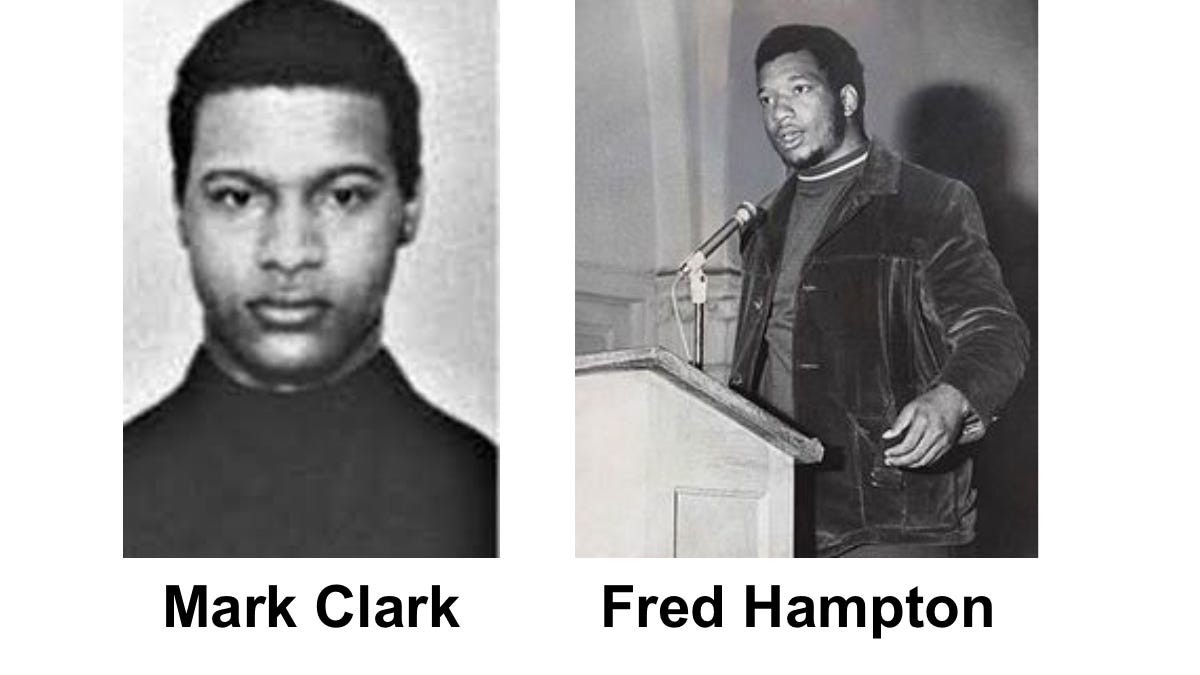THIS CRAZY DAY IN 1972: Have yourself a merry little holiday of any or no denomination
And Happy New Year!
To access all website contents, click HERE.
This spectacular view of Christmas on State Street is admittedly from 1958, but I couldn’t resist after seeing it tweeted by Vanished Chicagoland’s indefatigable proprietor Pete Kastanes. The streetlights so reminiscent of “War of the Worlds” were still there in 1972, so to update, just imagine this scene with uglier cars.
As regular readers know, we’ve been thrown off our 1972 timeline. So we’re not actually up to Christmas yet. Nonetheless, this week’s post brings you two Christmas treats from 1972—the first heartwarming, the second ridiculous. Scroll to “Jack Mabley’s Heartwarming Christmas” or click here to skip the announcements in between.
Announcements and Thanks
We’ll be back in January after a holiday break, starting with a look at the bombastic Cook County State’s Attorney campaign between incumbent Democrat Ed Hanrahan and his Republican challenger, former FBI agent Bernard Carey. It’s a wild finish as Hanrahan and Carey take the gloves off for their final debate.
Hanramania…
…meets Bernard Carey Watch.
Then, we’ll finally be ready for the results of the momentous November 8, 1972 election.
Will Ed Hanrahan and his jaw stay in office, even though Mayor Daley kicked him off the Democratic primary slate and he was just acquitted after a marathon trial for allegedly conspiring to obstruct the investigation of his office’s 1969 police raid that killed Black Panthers Fred Hampton and Mark Clark?
Will President Nixon beat George McGovern, even with Watergate breathing down his neck?
I can’t wait to find out.
Before getting into Christmas 1972, there are two points I’d like to cover as this site finishes its first year. My name is Cate Plys. I’m a former Chicago Reader staff writer, later op-ed columnist for the Sun-Times and then Tribune. Since the heart of this site is a novel with an unnamed narrator, I thought it made more sense to leave myself out of it. In that spirit, I probably won’t mention myself directly again. But I didn’t mean for it to be a state secret.
More importantly, I’d like to thank the people who have been most instrumental in helping me develop, improve and grow the site—aside from my family, who of course make all things possible. These people helped me immeasurably with their time, advice and support:
Don Evans, Demetria Giannisis, Rick Kogan, Robert Leighton, John McCormick, Charlie Meyerson, Michael Miner, Don Rose, and Tim Samuelson loom especially large for their repeated assistance. Dennis Stella was an early crucial source on Roseland matters, and helped kickstart subscriptions with a Facebook post.
Legendary Tribune reporter Ron Grossman graciously filled me in on short notice on numerous pieces of 1972 ephemera as well as providing invaluable insight into 1972 newspapers. Esteemed journalist and native Chicagoan Jonathan Alter generously recommends this site on his fascinating Substack, Old Goats, helping grow my subscriber base considerably. Charlie Meyerson plugged my very first post and several more in his estimable Chicago Public Square, and Eric Zorn included the site in his entertaining Picayune Sentinel’s Land of Linkin’ section.
Carol Marin made my heart flutter when she tweeted this about the Chicago Newspapers Circa 1972 post: “Need a superb history of Chicago newspapers? A must-read!” I’m indebted to all the reporters who shared their expertise and memories with me for that chapter, particularly Jerry Ackerman, Mary Knoblauch and Ethan Michaeli. [There will be more chapters on individual papers, and I am always happy to add and update, so if you have anything to share on 1972 newspapers, please get in touch! RoselandChicago1972@gmail.com]
Veteran Tribune reporter Barbara Mahany’s kind early encouragement was a terrific motivator in the first few months. I was especially fortunate to speak several times with indispensable Chicago journalist Hank DeZutter about newspapers and the Chicago Journalism Review before his death earlier this year. Sun-Times alum Susan Figliulo talked ‘72 newspapers with me, and supplied all the gorgeous roses used to illustrate this site.
Despite all the horrible things I heard about Twitter, I’ve found the Twitter users hovering around Chicago history and architecture to be endlessly fascinating and friendly. Pete Kastanes of Vanished Chicagoland is a one-man Chicago history machine all by himself. Also, a particular shout-out to @Chicago_Pod (Chicago History Podcast) proprietor Tommy Henry. See you December 27 for your Chicago Trivia Night at GMan Tavern, 3740 N. Clark, 8-10 PM! Booze and Chicago history, what could go wrong?
Finally, I am deeply grateful to all you readers—especially you subscribers. Yeah, it’s free—but we all have overflowing emailboxes, and countless other sources of content begging for our attention. Thank you for reading! Extra thanks to extra-helpful readers Bernie Cicirello, Garry, and James Costello.
Happy Holidays and New Year!
Jack Mabley’s heartwarming 1972 Christmas
A little background on Mabley first, because it’s directly relevant to this Christmas column.
As regular TCD1972 readers know, Jack Mabley is Chicago Today’s star columnist, appearing at the top of page 4.
But Mabley started his columnist days as the star at the Daily News. A generation older than Mike Royko, he was born in 1915 and grew up in Chicago. Royko served in the Korean War, didn’t go to college; Mabley went to the University of Illinois, and served in World War II. They both started out with the City News Bureau and got their first big city newspaper job with the Daily News.
After general reporting, Mabley wrote the Daily News’ first TV column. According to his laudatory obituary by Patrick Reardon and Ed Baumann, it was the first major newspaper TV column in the country. Mabley rose to his general interest column in 1957 and jumped to the Tribune-owned Chicago’s American in 1961, making room for a new columnist at the Daily News—who eventually turned out to be Mike Royko.
When Royko died in 1997, former Daily News colleague Myron Beckenstein wrote a tribute in the Baltimore Sun giving the following account of the Mabley-Royko succession. FYI, to avoid confusion—Beckenstein is wrong on the precise dates, and where Mabley went after leaving the Daily News:
His [Royko’s] chance came because of the green chair.
The green chair belonged to a Chicago Daily News columnist named Jack Mabley. He was pretty popular in town and wrote a pretty good column. He felt comfortable in his position and had no reason to fear for it. He had been in it for quite a while.
Then the green chair got in the way.
In late 1963 or early 1964, the Daily News (it was always the Daily News, never just the News) decided to redecorate its newsroom. Out with the old style of institutional office furniture, in with a new style of institutional office furniture.
And one of the elements of the new was new chairs. This was something Mabley would not put up with. He wanted to keep his old, wooden green chair.
For some reason, the editor du jour was adamant. All new chairs. No old chairs. No exceptions.
Mabley was adamant. The chair goes and I go, to the Chicago Tribune.
That should settle things.
It did. To the surprise of almost everyone, Mabley and his chair lost the clash of wills and he was told, if that's the way he felt about it, he could go.
Here’s the same story from the perspective of Henry Kisor, author and long-time book editor of the Sun-Times, one of the many who graciously gave me some time for the 1972 newspaper chapter:
“There was a story, perhaps apocryphal, that he went to the American when Field Enterprises bought the Daily News because Field brass wouldn’t allow him to bring his favorite ratty chair from the old Daily News building at W. Madison to the Sun-Times/DN building at 401 N. Wabash.”
Interesting—because the Daily News began moving into the Sun-Times building in April of 1960, but Mabley didn’t jump to Chicago’s American until February 1961. Not that it proves anything for sure about the green chair. It’s a good story, either way. Let’s teach the controversy.
Chicago’s American became Chicago Today in 1969, then folded in 1974. Mabley moved on to the Tribune, where he was their leading columnist until retiring in 1982. He began writing three times per week for the Daily Herald in 1988, and stayed all the way to 2004. Mabley finally retired again at 88—and began a blog.
Jack Mabley died in 2006, after writing over 12,000 columns.
Here is the photo that appeared with his Tribune obituary, taken in 1977:
Mabley was a bona fide Chicago newspaper star. As the Tribune’s John Gorman noted in 1987, “The promoter of the Beatles’ first American tour chose Mabley to introduce the group at the International Ampitheatre”. So it’s astonishing how quickly Mabley was forgotten. While working on the Chicago Newspapers Circa 1972 chapter, quite a few reporters of the time even told me that Chicago’s American and Chicago Today had no star columnist.
Mabley’s star was simply eclipsed by Mike Royko. Mabley’s column was good, often quite good in 1972—see his terrific column on the street riots during the 1972 Republican National Convention. But Royko was stellar. I don’t know if Jack Mabley found that annoying, but who wouldn’t? However, nobody should feel badly about being outshone by Mike Royko. You might as well be jealous of Shakespeare. I’ll address the Mabley-Royko relationship a bit further in Mike Royko 50 Years Ago Today soon. I can tell you they had a spat in print in 1990, and we’ll at least see that.
Back to Mabley himself. The Trib’s Eric Zorn quoted Daily Herald columnist Burt Constable in the Daily Herald in 2004 when Mabley retired from that paper:
“Jack exposed corruption, helped solve murders, got scoops from William Wrigley and George Halas, aggravated the first Mayor Daley…established the nation’s first Action Line consumer service…and did such a fair and impressive job covering the riotous 1968 Democratic Convention by foot and bicycle that he won praise from some members of the Chicago police force and from Yippie leaders such as Jerry Rubin.”
Jack Mabley’s most distinguished accomplishment was his work on behalf of mentally retarded children. Back to John Gorman writing in 1987:
“In the early ‘60s, Mabley toured the Dixon Center [for mentally retarded children] in Dixon, Illinois. After finding what even Dixon officials described as ‘a snake pit,’ he launched a statewide campaign to clean up institutions for the mentally retarded. A year later, patients ‘had their teeth brushed and hair combed…Injuries from scuffling and falls were cut in half.’
“Once physical amenities were improved, Mabley established the Forgotten Children’s Fund to provide money for residents of these institutions in Illinois to buy small treats year-round.”
The Forgotten Children’s Fund was still its own entity in the late ‘80s running alongside the larger general Tribune annual holiday fund drive. In 1987, the Dixon Center was replaced with a new then-$6 million facility, named the Jack Mabley Development Center.
Which brings us to Christmas 1972.
“Lincoln, Ill.—At 8 o’clock Christmas morning I set out to find the happiest spot in Illinois,” writes Jack.
“I found it, 60 miles south of Chicago, in the Kickapoo Street Apartments in Lincoln, Illinois.
“Oh, there were thousands of happy places in Illinois yesterday, but nowhere were the eyes brighter or the smiles broader than among the 54 young men and women who live in the Kickapoo Street Apartments.
“Donna Stevens is one. At 9:30 in the morning Donna and her friends lined up on both side of the hall, and sat down. Mildred Simpson and Edna Pele called out the names on the Christmas packages.”
Edna Pele tells Jack that when Donna arrived, “everybody said she couldn’t make it. But she has made it. She does her own washing and shopping and keeps her room neat and has a job and she’s just wonderful.”
“They all say this is the best Christmas,” Pele tells Mabley. “The best ever. I don’t know what happened, but there were so many presents. Look at these smiles.”
Jack explains that the Kickapoo Apartments used to house the doctors and staff for the Lincoln State School for the mentally retarded, across the street. But it’s been renovated into housing for adult school residents who are ready to move on. At Kickapoo, the residents live in their own apartments, learning to live on their own, most working jobs and getting paid.
“Thirteen years ago when I first visited Lincoln, Tommy Hudson was a little boy trapped in an overcrowded, stinking hellhole cottage at Lincoln,” writes Jack. “It was all the small staff could do to keep the messes cleaned up and the children clothed and not fighting one another. There was little training, pitiful supervision and no hope.
“Those nightmare days are gone. Today Lincoln, like its sister school in Dixon, has halved its population, and the staff has doubled. The awful smell is gone. Curtains are on the windows. Gardens have replaced cinders.
“Tommy Hudson is a fine-looking young man who is getting ready to leave Lincoln and earn his living at a turkey farm near Havana.
“Tommy never had a better day than yesterday [Christmas]. ‘I got a pair of socks and slippers, and shaving lotion,” he tells Jack.
“I asked him where his home is or was. ‘I was born in New York,’ he said. ‘I haven’t seen my mother for 16 years. I think she’s around someplace. I’m not sure.’ Edna Pele was listening. ‘But we love you, Tommy.’
“Tommy grinned. ‘Yes. That’s what counts.’”
The Lincoln School’s superintendent gave each resident with no family or money $5 (that’s $33.75 in 2022) from the Forgotten Children’s Fund to use for Christmas shopping.
Jack tours the campus with the superintendent. “Tommy Hudson asked if he could walk down the street with us. ‘It’s nice to have visitors,’ Tommy said.
“He walked along and chattered, and said so long as we got to the other building. Then he turned back toward the Kickapoo Street Apartments. As he walked, Tommy started singing, ‘Love Makes The World Go Round.’
“He didn’t know that we could hear him, and he wasn’t doing it for effect. He’s just a retarded youngster who’s no longer forgotten, and he knew the right song for Christmas 1972.”
Bob Hope’s ridiculous Christmas 1972
Chicago Sun-Times
by Jack Folsle
“BANGKOK—Bob Hope suffered the ultimate insult to a comic on his trip here—he had to explain a joke. His humble-pie performance came at a press conference called at the instigation of the U.S. Embassy.”
Bob Hope has toured Asia for the previous eight years putting on shows for U.S. troops, and every year he’s “joked about the Thai climate and customers”. This year, two Bangkok newspapers editorialized that Bob Hope was insulting the Thai people.
“He had said that kowpot, a bastardized Chinese-Thai dish intended for foreign consumption at inflated prices, was a meal intended only for cows. In his running repartee at Utapao Air Force Base last week, he had included among ‘in’ jokes for GIs that Bangkok canals smelled bad and that Thai politics was like Thai foot-and-fist boxing: No rule applies.”
The U.S. embassy responded to the Thai newspaper attacks on Hope “with alacrity, believing that the very foundations of U.S.-Thai relations were being rocked.”
So, “a puzzled Bob Hope” appeared at a press conference and tried to explain his jokes.
He “explained he had meant no offense when he said he had left his shoes outside a temple, as custom demands, and found two families living in the shoes when he exited. The gag, he explained to the assembled Thai press, was that he had big feet.
“‘Oh,’ said one reporter, ‘I thought you were belittling the size of the Thai people.’”

Finally, the U.S. ambassador to Thailand personally apologized: “Bob Hope is a friend of Thailand and he likes the Thai people. He may not be familiar with the Thai customs, but I am sure he would not purposely say anything to insult the Thai people.”
Did you dig spending time in 1972? If you came to THIS CRAZY DAY IN 1972 from social media, you may not know it’s part of the novel being serialized here, one chapter per month: “Roseland, Chicago: 1972” —FREE. It’s the story of Steve Bertolucci, 10-year-old Roselander in 1972, and what becomes of him. Check it out here.

















